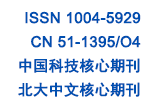



以非手性铕化合物为探针的手性氨基醇圆偏振荧光光谱
唐宇轩,贾国卿,张莹,冯兆池*,李灿*
以非手性铕化合物为探针的手性氨基醇圆偏振荧光光谱
Circularly Polarized Luminescence Spectroscopy of Chiral Amino Alcohols Probe Detected via Achiral Europium(Ⅲ) Complex
| {{custom_ref.label}} |
{{custom_citation.content}}
{{custom_citation.annotation}}
|
/
| 〈 |
|
〉 |